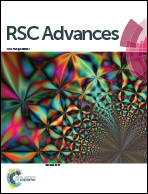Improving the anti-icing/frosting property of a nanostructured superhydrophobic surface by the optimum selection of a surface modifier†
Abstract
To understand the effect of chemical composition on the anti-icing properties of a nanostructured superhydrophobic surface (SHP), four SHP surfaces were prepared on glass, which was initially roughed by a radio frequency (RF) magnetron sputtering method and then modified with HDTMS (a siloxane coupling agent), G502 (a partially fluorinated siloxane coupling agent), FAS-17 (a fully fluorinated siloxane coupling agent) and PDMS (a kind of polysilicone widely used in power transmission lines). Results show that the anti-icing properties of these four SHP surfaces in glaze ice varied wildly and the as-prepared SHP surface which was modified with FAS-17 (SHP-FAS) demonstrated a superior anti-icing/frosting performance. Approximately 56% of the entire SHP-FAS remained free of ice after spraying it for 60 min with glaze ice, and the average delay-frosting time (the time taken for the whole surface to become covered with frost) was more than 320 min at −5 °C. Equivalent model analysis indicates that ΔG, defined as the difference in free energy of the Cassie–Baxter and Wenzel states, of the SHP-FAS is much lower than the other three SHP surfaces, giving priority to Cassie state condensation and the self-transfer phenomenon helping to effectively inhibit the frosting process by delaying the ice-bridging process, which is beneficial for improving the anti-frosting property. This work sheds light on and improves understanding of the relationship between anti-icing and anti-frosting properties and is helpful in making the optimum selection of a surface modifier for improving the anti-frosting/icing performances of a SHP surface.



 Please wait while we load your content...
Please wait while we load your content...